'I am not your scapegoat': See the art created by Asian Americans in a year of anti-Asian hate Favorite
In mid-November, the nonprofit group Asian American Federation released 10 travel posters designed to subvert a question that can instantly get under the skin of any person of Asian descent in the United States: “Where are you really from?”
At first glance, the prints — conceptualized by the ad agency Droga5 — look like futuristic, cubist renderings of familiar urban landscapes in cities like New York, Seattle, Houston and San Diego. But a closer inspection reveals distinct iconography honoring the lives of 10 Asian American trailblazers who call those places home.
Houston’s poster, for example, features imagery pulled from the childhood memories of Kevin Kwan, the author of “Crazy Rich Asians”: a rickety Asian grocery store with flickering fluorescent lights and an alternative record shop that he frequented with friends.
One of six posters labeled “I’m really from New York City” pays homage to Suki Terada Ports, the towering Japanese American activist who spearheaded the city’s first HIV/AIDS programs for Asian Americans.
The city through Ports’ eyes includes a scene in which her mother made dinner for 20 Japanese American soldiers during World War II and one in which Ports was arrested for protesting private development on public land.
Kezia Gabriella, the Singapore-based illustrator who crafted Ports’ print, said creating art during the height of anti-Asian racism has been both sobering and empowering.
“It was only recently that I actually talked more about my identity as an Asian artist,” Gabriella, who’s of Dutch, Chinese and Indonesian descent, said. Working on the project, she continued, taught her that “my race shouldn’t be the cause for racial discrimination or stereotype; it should just be a fact.”
Over the past year, as bias incidents and hate crimes against their community surged, Asian American artists in New York City and beyond have produced ambitious multimedia projects that explore the fragility, burden and joy of being Asian in America. In doing so, they’ve also raised tens of thousands of dollars for grassroots organizations and reinforced the power of art to turn grief into a rallying cry.
In late spring, photographer Andrew Kung and product designer Kathleen Namgung dropped “Perpetual Foreigner,” a photo series that styled Asian Americans in clothing from '90s fashion campaigns and framed them against bucolic settings. A particularly intimate photo shows Kung’s parents locked in an embrace on a yellow picnic blanket.
“The imagery we wanted to paint was one of celebration and belonging,” Kung said, “an ideal landscape of what it could look like if Asian Americans were accepted in this country.”
The calm bliss that radiates from the photos might seem jarring amid the racial violence that has ravaged the Asian diaspora, but Kung and Namgung had no interest in dwelling on grief and loss.
“I don’t think trauma should be a part of anyone’s experience,” Namgung, the project’s creative director, said. “That’s just an unnecessary outcome of racism that we unfortunately have to face.”
Following the mass shooting at three Atlanta-area spas in March, photographer Cindy Trinh and actor Christine Fang began working on a multimedia project to capture the fetishization and harassment that follow many Asian women and nonbinary people on a near-daily basis. “Invisible No More,” which was released during Asian Pacific American Heritage Month, in May, is a portrait series highlighting the stories of 16 female and female-identifying Asian Americans.
“This project for both of us really started out of need,” Fang said. “Our hearts were on fire. Our souls were in need of just something.”
Trinh and Fang asked the participants to share the fraught racial dynamics they’ve experienced at work and in relationships or casual encounters. Fang reworked each interview into a short monologue that she recruited different actors to read, then layered the audio recordings over Trinh’s portraits.
The project has helped some participants reclaim parts of their culture that white people have exploited and shamed. After a Vietnamese woman shared that she was mocked for smelling like pho, Trinh shot her portrait with her head and face covered in pho noodles.
“Doing these art projects is so important because it helps us realize and remember we aren’t alone in the struggle,” Trinh said. “Coming together is how we can continue to heal ourselves and fight oppression.”
Last winter, as violent attacks against Asian elders began to spike, vividly painted portraits of Asian, Pacific Islander and Black people — flanked by vibrant florals and messages like “I am not your scapegoat” — appeared on the walls of New York City's busiest subway and bus stops.
Amanda Phingbodhipakkiya’s “I Still Believe In Our City” public art series, created in partnership with the New York City Commission on Human Rights, reminded millions of commuters of the humanity, diversity and beauty of Asian Americans at a time when many saw them as mere carriers of a deadly virus.
“The city became a sprawling campus on which I can lay bare grief and amplify our joy and really wrap our community in love and belonging,” Phingbodhipakkiya, who’s of Thai and Indonesian descent, said.
Some elements of the project were lifted directly from her own trauma: She said many of the mantras that accompany the portraits, such as “I did not make you sick” and “We too are America,” were words she wished she could have said to a man who verbally abused her on the subway.
“It’s important to stop people in their tracks because we live in such a noisy world,” she said. “Art can speak in an instant what written words would take people much longer to absorb.”







